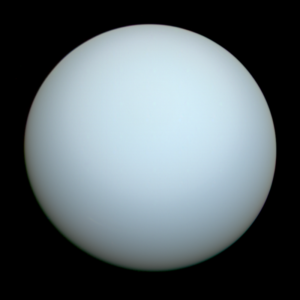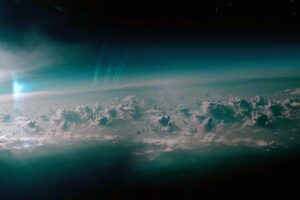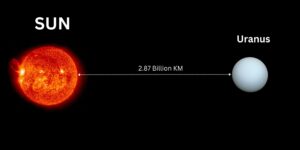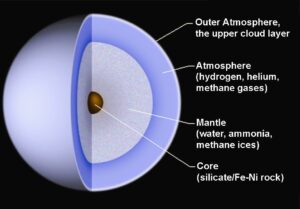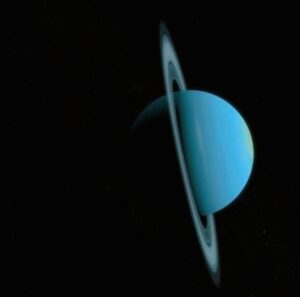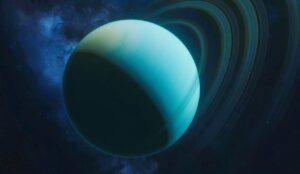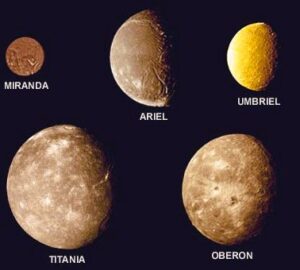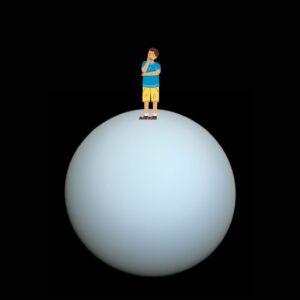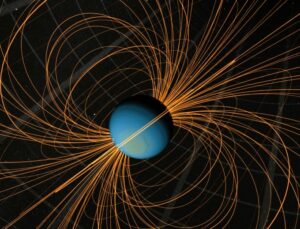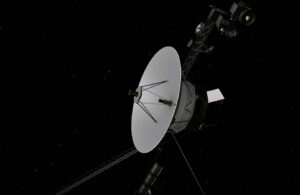- abaashishb7
- April 10, 2024
- 6:07 pm
- No Comments
Uranus Planet
अरुण ग्रह
* Uranus : Extreme Tilt and Pale Blue Color
Uranus, the seventh planet from the Sun, is a unique and mysterious member of our
solar system. Named after the Greek god of the sky, Uranus was discovered in 1781 by
the astronomer Sir William Herschel. It is the third-largest planet in terms of diameter
and fourth-largest by mass, but it stands out for its distinct characteristics that set it
apart from its neighboring planets.
* Discovery of Uranus
1:- Discovery Date: Uranus was discovered on March 13, 1781, by the British astronomer
Sir William Herschel. Herschel was not searching for a new planet but rather
observing the night sky with his homemade telescope.
2:- Observations: While scanning the constellation of Gemini, Herschel noticed a faint
object that appeared to move relative to the fixed stars. Initially, he thought he had
discovered a comet.
3:- Verification: However, as he continued to observe the object’s movement, he realized
it was not a comet but a new planet located beyond Saturn. This was a
groundbreaking discovery, as it was the first planet to be discovered with a telescope.
4:- Naming: Initially, Herschel wanted to name the planet “Georgium Sidus”
(George’s Star) after King George III of England, who was his patron. However, this
name was not universally adopted outside of England.
5:- Uranus: The German astronomer Johann Elert Bode suggested the name “Uranus,”
after the Greek god of the sky and father of Saturn. This name had historical and
mythological significance, fitting with the tradition of naming planets after deities.
6:- Impact: The discovery of Uranus had profound implications for astronomy. It
extended the known boundaries of the solar system and challenged the traditional
view that there were only six planets (Mercury, Venus, Earth, Mars, Jupiter, and
Saturn).
7:- Calculations: After the discovery, astronomers like Alexis Bouvard and others noticed
discrepancies in the orbit of Uranus. These irregularities led to the prediction that
there might be another planet beyond Uranus, influencing the eventual discovery of
Neptune in 1846.
Sir William Herschel’s accidental discovery of Uranus opened new frontiers in the study
of the solar system and paved the way for a deeper understanding of its structure and
dynamics. Today, Uranus remains a fascinating object of study for astronomers and
space missions, providing valuable insights into the mysteries of our celestial
neighborhood.
* Dimension Of Uranus
1:- Equatorial Diameter: The equatorial diameter of Uranus is approximately 50,724
kilometers (31,518 miles). This measurement represents the distance across the
planet from one side to the other at its equator.
2:- Polar Diameter: The polar diameter of Uranus is about 49,946 kilometers
(31,035 miles). This measurement represents the distance from the top of the
planet to the bottom, passing through its center.
3:- Mean Radius: The mean radius of Uranus, which is the average distance from its
center to its surface, is roughly 25,362 kilometers (15,759 miles).
4:- Circumference: The circumference of Uranus at its equator is approximately 159,354
kilometers (98,787 miles). This measurement represents the distance around the
planet’s equator.
5:- Surface Area: The total surface area of Uranus is estimated to be around 8.1 x 10^9
square kilometers (3.1 x 10^9 square miles). This area covers the entire surface of
the planet, including its atmosphere and any solid surfaces.
6:- Volume: The volume of Uranus is approximately 6.8 x 10^13 cubic kilometers
(1.6 x 10^13 cubic miles). This volume represents the amount of space enclosed by
the planet’s surface.
7:- Mass: Uranus has a mass of about 8.68 x 10^25 kilograms (1.9 x 10^26 pounds).
This mass is roughly 14.5 times that of Earth’s mass.
* Key Fact of Uranus
Distance from the Sun
1:- Average Distance: Approximately 2.87 billion kilometers (1.78 billion miles)
2:- Perihelion (Closest Approach to Sun): About 2.72 billion kilometers
(1.69 billion miles)
3:- Aphelion (Farthest Distance from Sun): Around 3.01 billion kilometers
(1.87 billion miles)
Orbital Period (Year)
Uranus takes about 84 Earth years to complete one orbit around the Sun.
Since Uranus has a significantly tilted axis of rotation (about 98 degrees), its seasons
are extreme and last about 21 Earth years each.
Day Length
A day on Uranus (one full rotation on its axis) lasts about 17.24 Earth hours.
Size
1:- Diameter: Approximately 50,724 kilometers (31,518 miles)
Uranus is the seventh-largest planet in our solar system.
Gravity
1:- Surface Gravity: About 8.69 m/s² (equivalent to 0.886 times Earth’s gravity)
Appearance
Uranus has a pale blue-green color due to the presence of methane in its atmosphere,
which absorbs red light and reflects blue-green light.
Its distinct feature is its extreme axial tilt, where it essentially rotates on its side
compared to other planets, likely due to a past collision.
The tilt causes Uranus to have unusual seasons, with each pole facing the Sun for about
21 years during its orbit.
Surface Features
Uranus, being a gas giant like Jupiter and Saturn, does not have a solid surface.
It has a deep atmosphere primarily composed of hydrogen, helium, and methane.
Like Jupiter and Saturn, it likely has a small solid core surrounded by layers of liquid and
gas.
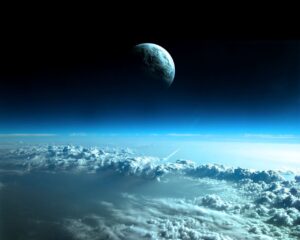
Atmosphere
1:- Composition: Uranus’ atmosphere is mainly hydrogen and helium, similar to Jupiter
and Saturn, but it also contains a higher proportion of “ices” such as water, ammonia,
and methane.
The presence of methane in Uranus’ atmosphere is responsible for its blue-green color.
Uranus’ upper atmosphere has bands of clouds and high-speed winds, reaching speeds
of up to 900 kilometers per hour (560 miles per hour).
Moons
Uranus has 27 known moons as of the latest count.
Among the largest moons are Miranda, Ariel, Umbriel, Titania, and Oberon.
These moons have varied surface features, with some showing signs of past geological
activity and others covered in icy surfaces.
* Composition of Uranus
The composition of This Planet, the seventh planet from the Sun, is primarily made up of
hydrogen, helium, and “ices” such as water, ammonia, and methane. Here’s a breakdown
of This Planet’ composition
1:- Hydrogen (H2):
The majority of This Planet’ atmosphere is hydrogen, making up about 82.5% of its
composition by volume.
2:- Helium (He):
Helium is the second most abundant element in This Planet’ atmosphere, comprising
about 15.2% of its composition.
3:- Methane (CH4):
This Planet’ atmosphere also contains a significant amount of methane, making up
about 2.3% of its composition.
Methane is responsible for the planet’s pale blue-green color, as it absorbs red light
and reflects blue-green light.
4:- “Ices” (Water, Ammonia, Methane Ice):
This Planet has higher concentrations of “ices” compared to Jupiter and Saturn.
These ices include water (H2O), ammonia (NH3), and methane (CH4) in solid form,
which are mixed with the hydrogen and helium in its atmosphere.
The presence of these ices gives This Planet its bluish appearance.
5:- Other Trace Gases:
This Planet’ atmosphere also contains traces of other gases such as hydrogen
sulfide (H2S), which contributes to the planet’s odor (if one were to visit This Planet,
they would perceive a foul smell due to this compound).
* Structure of Uranus
Core
This Planet likely has a small, rocky core at its center. This core is estimated to be about
55% of the planet’s total mass.
The core is surrounded by a mantle of water, ammonia, and methane ices.
Mantle
Surrounding the core is a layer of icy mantle, composed primarily of water, ammonia,
and methane ices.
This mantle layer is relatively thick and extends outward from the core.

Atmosphere
Above the icy mantle is This Planet’ atmosphere, which is primarily composed of
hydrogen and helium, along with traces of methane, water vapor, and other gases.
The atmosphere is divided into several layers, each with different temperatures and
compositions.
This Planet’ upper atmosphere has bands of clouds, with the bluish appearance due to
the presence of methane, which absorbs red light and reflects blue-green light.
The winds in This Planet’ atmosphere can reach speeds of up to 900 kilometers per hour
(560 miles per hour), making it one of the windiest planets in our solar system.
Extreme Axial Tilt
One of the most unique features of This Planet is its extreme axial tilt. While most
planets in our solar system have relatively small axial tilts, This Planet is tilted at about
98 degrees.
This means that This Planet essentially rotates on its side as it orbits the Sun, causing
extreme seasons. Each pole experiences 21 years of continuous sunlight followed by 21
years of darkness.
Rings
This Planet has a system of rings, although they are much fainter and less extensive
than Saturn’s rings.
The rings of This Planet are composed of dark particles, likely consisting of water ice
and rocky debris.
Moons
This Planet has 27 known moons as of the latest count, each with its own
characteristics and features.
Among the larger moons of This Planet are Miranda, Ariel, Umbriel, Titania, and Oberon.
These moons vary in size, composition, and surface features, with some showing signs
of past geological activity.
This Planet has a layered structure with a rocky core, an icy mantle, and a hydrogen-
helium atmosphere. Its extreme axial tilt, unusual blue-green color due to methane, and
system of rings and moons make it a fascinating and unique planet in our solar system.
Further study of This Planet, including potential future missions, could provide more
insights into its composition, structure, and complex atmosphere.
* What Would Happen if a Human Were to Enter Uranus
If a human were to somehow enter Uranus’ atmosphere or attempt to land on the planet
itself, it would be an extremely hazardous and ultimately fatal endeavor. Here’s what
would likely happen
Entry into the Atmosphere
As the human descended into Uranus’ atmosphere, they would encounter intense
pressure and extreme cold.
Uranus’ atmosphere is composed mainly of hydrogen, helium, and methane. The
pressure increases rapidly with depth, becoming crushing at lower altitudes.
The temperature in Uranus’ upper atmosphere can drop to about -224 degrees Celsius
(-371 degrees Fahrenheit).
Lack of Breathable Air
Uranus’ atmosphere lacks oxygen, so a human would not be able to breathe without a life
support system.
The methane in Uranus’ atmosphere, which gives the planet its blue-green color, would
also be toxic to humans if inhaled.
Extreme Cold
The frigid temperatures would quickly freeze any exposed skin or unprotected parts of
the human body.
This Planet is one of the coldest planets in our solar system, with temperatures dropping
as low as -224 degrees Celsius (-371 degrees Fahrenheit) in the upper atmosphere.
Pressure and Crushing Force
As the human descended further into This Planet’ atmosphere, the pressure would
increase dramatically.
At lower altitudes, the pressure would become so great that it would crush the human
body almost instantly, similar to being at the bottom of an ocean many kilometers deep.
No Solid Surface
Like the other gas giants in our solar system, This Planet does not have a solid surface.
Its “surface” is a transition zone where the atmosphere becomes denser and turns into a
liquid. There is no solid ground to land on or stand upon.
Attempting to enter This Planet would result in a series of fatal events. The extreme cold,
lack of breathable air, intense pressure, and absence of a solid surface make it impossible
for humans to survive on or in This Planet. It’s crucial to remember that This Planet, like
the other gas giants in our solar system, is an inhospitable and hostile environment for
human life.
* Unique Characteristics of Uranus
Extreme Axial Tilt
Uranus is known for its extreme tilt, often referred to as being “on its side.” Its rotational
axis is tilted at about 98 degrees, compared to Earth’s 23.5-degree tilt.
This unusual tilt means that Uranus essentially rotates perpendicular to its orbital plane
around the Sun.
As a result of this extreme axial tilt, Uranus experiences extreme seasonal variations.
Each pole of the planet is in continuous daylight for about 21 years, followed by 21 years
of darkness.
Pale Blue-Green Color
Uranus has a distinctive pale blue-green color, which is due to the presence of methane
in its atmosphere.
Methane in the atmosphere absorbs red light and reflects blue and green wavelengths,
giving Uranus its unique hue.
This coloration is different from the predominantly brown and beige colors of Jupiter
and Saturn.
Ring System
Like Saturn, This Planet has a ring system, although it is much fainter and less extensive.
The rings of This Planet were first discovered in 1977 when they were observed to
occult a star.
The rings are dark and composed of mostly small particles, likely consisting of water ice
and rocky debris.
Moons
This Planet has a system of 27 known moons as of the latest count, each with its own
characteristics and features.
Among the larger moons of This Planet are Miranda, Ariel, Umbriel, Titania, and Oberon.
Miranda, one of the innermost and smallest of This Planet’ five major moons, has some
of the most varied and interesting terrain in the solar system, including huge fault
canyons and icy terraces.
Coldest Planet
This Planet is one of the coldest planets in our solar system, with temperatures dropping
as low as -224 degrees Celsius (-371 degrees Fahrenheit) in its upper atmosphere.
This extreme cold is due to its distance from the Sun and its low internal heat.
Rapid Rotation
Despite its extreme tilt, This Planet has a relatively fast rotation on its axis.
A day on This Planet (one full rotation) takes about 17.24 Earth hours.
Tilted Magnetic Field
The most distinctive feature of This Planet’ magnetic field is its significant tilt relative to
its rotational axis.
While most planets have magnetic fields that are roughly aligned with their axes of
rotation, This Planet’ magnetic field is tilted at about 60 degrees from its axis.
This tilt is much more pronounced than any other planet in our solar system, making
This Planet’ magnetic field highly unusual.
Magnetic Poles
Due to this tilt, the magnetic poles of This Planet are not aligned with its geographic
poles.
The magnetic north pole of This Planet is closer to its equator than to its geographic
north pole.
This creates a unique and complex magnetic field configuration for the planet.
Magnetic Strength
This Planet’ magnetic field is weaker compared to the magnetic fields of other gas
giants like Jupiter and Saturn.
The strength of This Planet’ magnetic field at the equator is about 0.23 Gauss, which is
significantly weaker than Earth’s magnetic field (about 0.5 Gauss at the surface).
Limited Exploration
This Planet has only been visited by a single spacecraft, Voyager 2, which flew by the
planet in 1986.
Voyager 2 provided the first and only close-up images of This Planet, revealing its rings,
moons, and atmosphere in greater detail.
These unique characteristics make This Planet a fascinating and enigmatic world, with
much left to discover and understand. Its extreme tilt, pale blue-green color, faint ring
system, and diverse moons make it a subject of ongoing study and interest among
astronomers and planetary scientists.
* Modern Exploration of Uranus
Exploration of Uranus has been limited compared to some other planets in our solar
system. The only spacecraft to have visited Uranus to date is Voyager 2, which
conducted a flyby of the planet in 1986. Here is an overview of the modern exploration
of Uranus
Voyager 2 Mission (1986)
The Voyager 2 spacecraft, launched by NASA in 1977, conducted a grand tour of the
outer planets of our solar system.
On January 24, 1986, Voyager 2 made its closest approach to Uranus, coming within
81,500 kilometers (50,600 miles) of the planet’s cloud tops.
During its flyby of Uranus, Voyager 2 collected valuable data and images, providing the
first and only close-up views of the planet and its moons.
Some of the key discoveries and observations from Voyager 2’s This Planet encounter
include –
Detailed images of This Planet’ atmosphere, revealing its pale blue-green coloration due
to methane.
Observations of This Planet’ ring system, confirming the presence of 11 narrow rings.
Study of This Planet’ moons, including Miranda, Ariel, Umbriel, Titania, and Oberon,
providing insights into their sizes, compositions, and surface features.
Measurement of This Planet’ magnetic field and radiation environment.
Future Exploration Concepts
While there have been no further missions to This Planet since Voyager 2, there have
been proposals and concepts for potential future exploration. Some of these ideas
include
This Planet Orbiter and Probe
Proposed missions involve sending an orbiter to This Planet to study the planet, its
atmosphere, rings, and moons in greater detail.
A probe could be deployed to descend into This Planet’ atmosphere, providing direct
measurements and sampling.
Ice Giant Mission
NASA’s Planetary Science Decadal Survey, released in 2011, identified a potential future
mission called the This Planet Orbiter and Probe, part of a broader Ice Giant Mission
concept.
This mission would involve studying both This Planet and Neptune, the two ice giants of
our solar system.
Missions by Other Space Agencies
Other space agencies, such as the European Space Agency (ESA) and international
collaborations, have also considered missions to This Planet.
These missions could involve partnerships with NASA or independent explorations of
This Planet and its moons.
Challenges and Considerations
Exploring This Planet presents several challenges, including the long travel times due to
its distance from Earth, the extreme cold and radiation environment, and the need for
specialized spacecraft and instruments. Additionally, funding and mission priorities
often influence which planetary exploration missions move forward.
While there are no imminent plans for a dedicated This Planet mission, the interest in
studying this enigmatic planet and its unique characteristics remains high among the
scientific community. Future missions could provide new insights into This Planet’
atmosphere, magnetic field, moons, and rings, expanding our understanding of this
distant ice giant.
- abaashishb7
- April 10, 2024
- 6:07 pm
- No Comments


